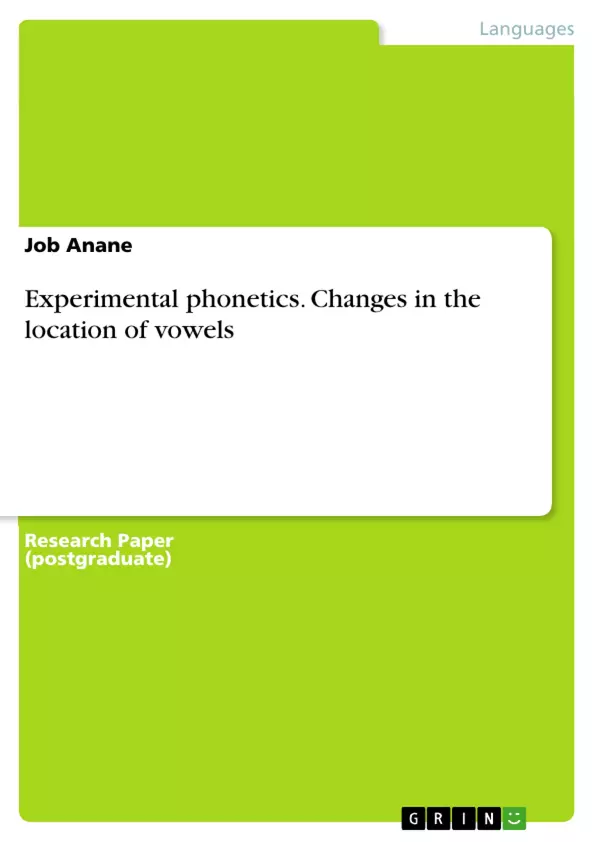The positions of individual vowels in the acoustics vowels space often change over time in languages of which Asante-Twi a dialect of Akan is not an exception. Sound changes in languages are typically associated with social factors like age, gender, social class. This study will explore the changes in the location of vowels as produced by four generational of speakers of Asante-Twi speakers. Fant (1966) also posits that since the length of the vocal track determines the overall patterns change, age and depend on gender. The current study will therefore investigate whether generational differences can affect vowel quality by comparing speakers of Asante-Twi with ages 6-14, 19-24, 40-50 and 60+.
Inhaltsverzeichnis (Table of Contents)
- Introduction
- Background of the Language (Akan)
- The Vowel System of Akan
- Statement of the Problem
- Objectives of the Research
- Related Studies
- Methodology
- DATA ANALYSIS
- Discussion/Results
- Conclusion
Zielsetzung und Themenschwerpunkte (Objectives and Key Themes)
This research aims to investigate the impact of generational differences on vowel quality within the Asante-Twi dialect of the Akan language. By comparing speakers of four different age groups (6-14, 19-24, 40-50, and 60+), the study seeks to understand how vowel production changes across generations.
- Generational influences on vowel quality in Asante-Twi
- Acoustic characteristics of vowels across different age groups
- Comparison of vowel production among speakers of various generations
- The role of social factors in shaping vowel sounds
- Vowel system and changes in Asante-Twi
Zusammenfassung der Kapitel (Chapter Summaries)
- Introduction: This chapter introduces the study, emphasizing the dynamic nature of vowel sounds in languages, specifically in Asante-Twi. It highlights the research question and the four generational groups involved in the study.
- Background of the Language (Akan): This chapter provides a comprehensive overview of the Akan language, including its geographical distribution, linguistic family, and its prominence in Ghanaian society. The focus is on the Asante-Twi dialect and its place within the wider Akan language system.
- The Vowel System of Akan: This chapter explores the phonetic characteristics of the Akan vowel system, specifically focusing on the oral and nasalized vowels. It mentions the work of Dolphyne (2006) regarding the distinct vowel systems of Asante-Twi and Fante dialects.
- Statement of the Problem: The chapter outlines the existing research on Akan vowels, highlighting the need for more systematic research on generational differences in vowel quality. The research question is stated, emphasizing the gap in current understanding.
- Objectives of the Research: This chapter clearly defines the research goals, focusing on gaining a deeper understanding of how generational differences impact vowel quality among Asante-Twi speakers.
- Related Studies: This chapter reviews previous studies on the impact of generational and dialectal differences on vowel quality. It presents key findings from relevant research by Jacewicz and Fox (2012), Auszmann and Neuberger (2014), Mayr and Siddika (2016), Dihingia and Choudhury (2016), and Grama (2015).
Schlüsselwörter (Keywords)
The study focuses on the core concepts of **vowel quality**, **generational differences**, **acoustic phonetics**, **Asante-Twi**, **Akan language**, and **sociolinguistics**. These key terms are integral to understanding the research objectives and its potential contributions to the field.
- Citation du texte
- Job Anane (Auteur), 2017, Experimental phonetics. Changes in the location of vowels, Munich, GRIN Verlag, https://www.grin.com/document/431134



